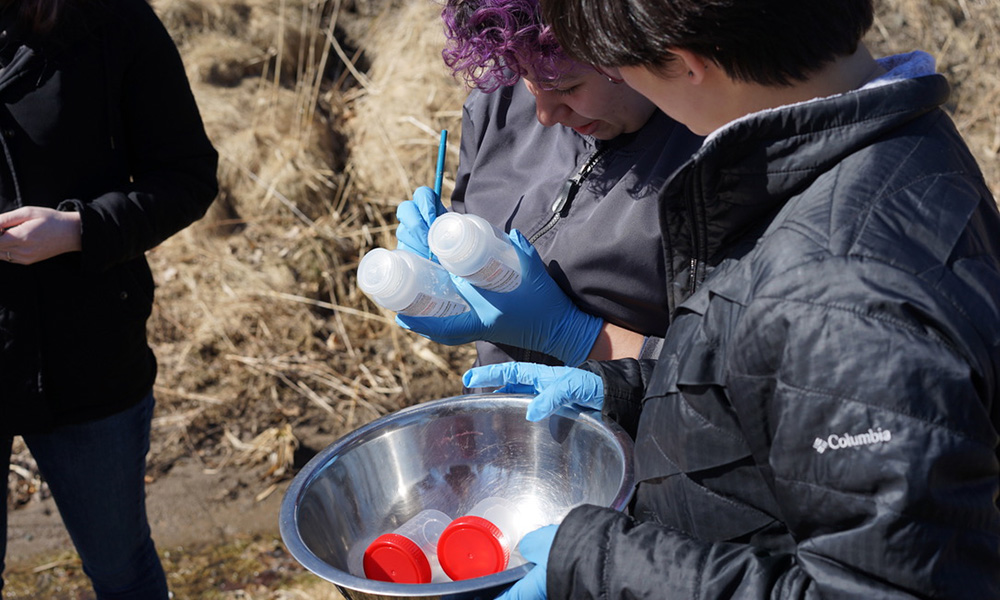Airborne Emissions of PFAS Can Contaminate Soil and Groundwater
Sep. 8th 2022What are “forever chemicals” and how do they get into the environment? This is a question that community members in Bennington, Vermont have asked researchers to investigate.
PFAS, nicknamed forever chemicals because they take so long to break down in the environment, are a group of nearly 5,000 hazardous chemicals, many of which are not regularly monitored. PFAS chemicals are found in many consumer products including Teflon (nonstick) cookware, waterproof rain gear, firefighting foam, and stain-resistant fabrics. As the chemicals leach into our natural environment, scientists have begun to research the effects that these chemicals can have on human and ecological health.
In Bennington, Vermont, and Hoosick Falls, New York, a team of researchers responded to a community need for PFAS education and research. The Bennington and Hoosick Falls area housed three Teflon coating operations for over 50 years, some of which have now been retired. These PFAS emission sources have resulted in residential soil and water contamination.
In this study, Tim Schroeder and Janet Foley of Bennington College and David Bond of the Center for the Advancement of Public Action investigated if airborne PFAS emissions from manufacturers led to soil and groundwater contamination at significant distances from the emission sources. Bennington, the location of the retired ChemFab factory, was an ideal site to test point source pollution. The town is surrounded by the Green Mountain National Forest, meaning the contamination they found was closely linked to the Teflon coating operation rather than being caused by other non-point sources.The researchers investigated the potential for the factory to contaminate soil and groundwater through airborne emissions.
They used wind patterns in the area to determine testing sites by proximity to the PFAS emissions from the Teflon plants. The research team took multiple soil samples and groundwater samples at each testing site to determine contamination and sampled a total of 73 sites for the study.
The researchers studied the contamination of multiple PFAS chemicals in the region including PFOA, the predominant chemical emitted in the neighboring factory. Researchers found PFOA soil concentrations in the local and downwind samples were more than three times higher than those of the other three areas tested which were not downwind from the emission site. However, PFOS concentrations, another type of PFAS chemical which was not emitted by the factories, were not significantly different among the testing sites. This further supports the idea that PFAS contamination is caused by the factories. The association between PFAS groundwater contamination and the airborne proximity to the factory quantified in this study convinced the corporation that owns the factories to agree to settle a lawsuit brought by the Vermont Department of Environmental Conservation.
These results indicate that air emitted PFAS can cause soil contamination downwind from emission sites which include areas that are not usually considered in environmental investigations because they are uphill from the emission site. This also showed that air emitted PFAS can impact groundwater by leaching out of soils. This led the researchers to investigate what concentration of PFAS contamination in soils begins to impact groundwater.
“The important thing to realize about PFAS contamination is that it is completely ubiquitous,” explains Schroeder, Professor of Earth Science at Bennington College. “Because PFAS chemicals are so widely used, they can be transported far through air or water and do not break down in the environment; most soil, everywhere on the Earth, contains measurable PFAS. Our research, in a very preliminary way, suggests that soil contamination of up to about 1 part-per-billion of PFOA will not leach to groundwater at concerning levels.”
Soil PFOA concentrations measured ranged from 3 to 23 parts-per-billion. However, the level at which PFOA will leach into groundwater seems to be dependent on soil composition and is likely different for different PFAS species. Study results indicated a strong correlation between soil organic carbon and PFOA contamination; soils with higher soil organic carbon retain higher concentrations of PFOA. Additionally, land use can affect soil retention of chemicals. Using data from the National Land Cover Dataset, the researchers analyzed their sampling based on land cover. They found that developed land leached more chemicals from the soils into groundwater, while forested soils retained more.
Soils with the right characteristics—high organic matter and forested land cover—can retain much more of the PFAS contamination than other soils, which helps to prevent groundwater contamination. Groundwater PFAS contamination is a pathway for PFAS to reach the human body which is important to investigate for human health risks.
“Our observations indicate that multiple factors need to be considered when assessing the potential for PFAS to leach from soil to groundwater,” said Schroeder. “It is likely that soil PFOA levels were higher in the Bennington valley while the ChemFab factory was active and that a portion of that soil PFOA has now leached into groundwater—while in the Green Mountains and other forested areas, a higher fraction of the PFOA deposited in soils has been retained rather than leached.”
Studying how these chemicals interact with the environment is crucial as concentrations continue to increase and we learn more about associated health risks. It is important to understand baseline levels of contamination as researchers continue to investigate high concentration areas. Schroeder and his team urge environmental investigations of manufacturing facilities to expand their scope of groundwater testing to consider downwind regions in addition to downhill groundwater flow. The researchers hope to set up long term monitoring of groundwater PFAS in the Bennington area to further understand PFAS contamination dynamics.
 ecoNEWS VT
ecoNEWS VT